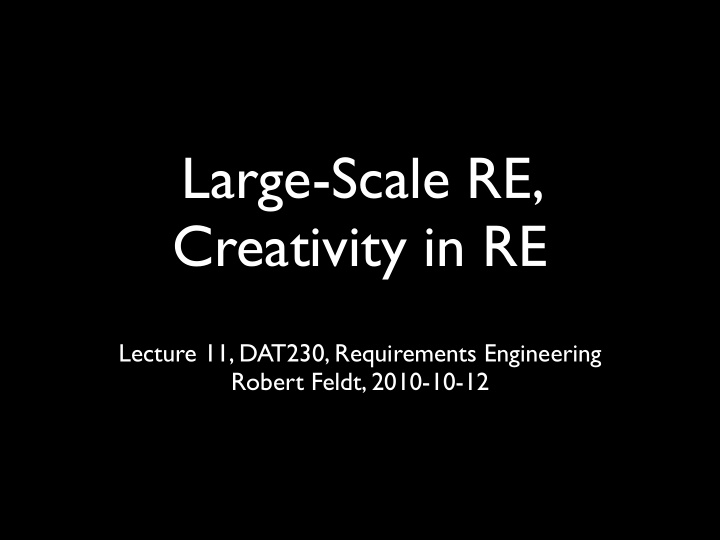



Large-Scale RE, Creativity in RE Lecture 11, DAT230, Requirements Engineering Robert Feldt, 2010-10-12
Notes about course • Individual assignment 3 is canceled • Written exam: Tuesday 19th of October 14:00-18:00 in V- huset, Chalmers Johanneberg • No previous example exam available • 3 types of questions: • Fact (simple, based on books/articles/slides) • Do (performing RE tasks, based on project & applying books/articles/slides) • Think (extrapolate/discuss based on your knowledge, no “given” answer in material)
Recap from last lecture
[Wnuk2009]
LSRE Challenges • Large number of customer requirements • Formal interface to customer • Management of customer expectations • Changing technology • Traceability • Scope change and creep • Resource fluctuation
[Wnuk2009]
[Wnuk2009]
[Wnuk2009]
Creativity in RE Creativity = ability to produce work that is both novel (original, unexpected) and appropriate (useful, adaptive concerning task & constraints) [Sternberg&Lubart1995]
Creativity Workshops for RE [Maiden2007]
Divergent & Convergent Thinking
Divergent & Convergent Thinking Divergent thinking = generate creative ideas through exploring multiple alternatives/ possibilities
Divergent & Convergent Thinking Divergent thinking = generate creative ideas through exploring multiple alternatives/ possibilities Convergent thinking = select “correct” ideas among many alternatives
Divergent thinking • Not correlated with IQ, but with: • nonconformity, curiosity, risk taking, persistence, musicians • Can be promoted through: • creating lists of questions • time “off” to think and meditate • brainstorming • bubble mapping • keeping a journal, free writing (“stream of thought”) • artwork
Three types of creativity
Three types of creativity Exploratory = explore new ideas within a given conceptual space (accepts constraints/ assumptions of given space)
Three types of creativity Exploratory = explore new ideas within a given conceptual space (accepts constraints/ assumptions of given space) Transformational = deliberate transformation or transcendence of a conceptual space (rejects some constraints/assumptions of given space)
Three types of creativity Exploratory = explore new ideas within a given conceptual space (accepts constraints/ assumptions of given space) Transformational = deliberate transformation or transcendence of a conceptual space (rejects some constraints/assumptions of given space) Combinatorial = novel combination of existing ideas as search through space
Four steps of creativity • Preparation - research = collect information/data • Incubation - percolation = milling over collected info • Illumination - light bulb = aha moment • Verification/Implementation - creation = check realism
Maiden Case Study • Two-day workshop to create new reqs/ideas • Product: Air Traffic Management system • Process: • 2 system engineers + domain experts: 4 months to establish high-level spec with scope and goals • 2-day Creativity workshop = 2 facilitators + 2 scribes + 2 external experts + 19 stakeholders • Focus on use case models and texts + I* models
Maiden Case Study • 4 half-day session in 2 days • All ~20 people in one room • Models & text printed on 1m2 pin boards around room • Physical and logical structure of ideas and reqs • Rules: No criticism during divergent periods, time-boxing different topics strictly • Post it notes, colored pens, idea cards at hand
Maiden Case Study Day 1 Day 1 Day 2 Day 2 morning afternoon morning afternoon Brainstorming Expert pres: Reflection Created (system wide & Design of Storyboards use case museum Expert pres: TV for high-prio specific) exhibitions program use cases scheduling Constraint Analogy Combining identification & mapping to Analogy ideas removal ATM & idea mapping & idea creation creation Revised use Brainstorming cases, models given removed Reporting back Reporting back & texts constraints
Analogical mapping/reasoning • Can help Exploratory creativity • Steps: • Find similar domain (source) to target domain • Identify and list mappings between • Agents, Objects, Actions, Constraints, Goals • Use each mapping in turn to create new idea by transforming solution between domains
Constraint removal • Can help Transformational creativity • Steps: • Identify constraints through brainstorming • Divide in small groups • Groups consider new ideas by consecutive removal of constrinats until none remains • Report back and put on boards
Storyboarding • Can help Combinational creativity • Steps: • Divide in small groups • Groups have 1 A1 paper with 16 cartoon boxes to describe a scene of a use case • Report back
Case study results
Summary of results • Captured both novel and unoriginal ideas • that were useful and affected SRS • 106 of 140 ideas was useful • 42 of 139 ideas was novel • More effect on abstract goals and concepts than actual reqs • Constraint removal effective but needs more structure • Sometimes hard to record all ideas (“idea blizzards”) • Analogy techniques not very cost-effective
Recommend
More recommend